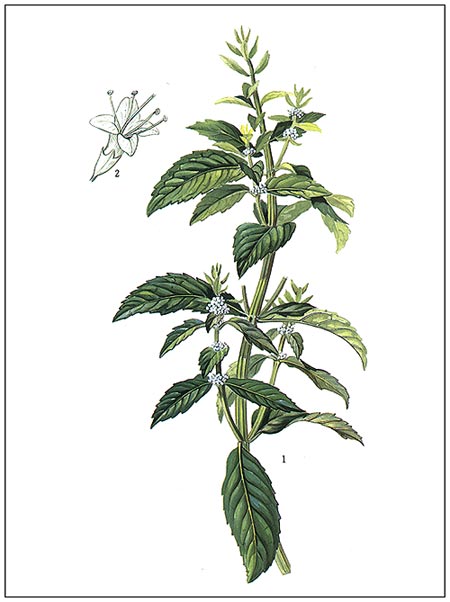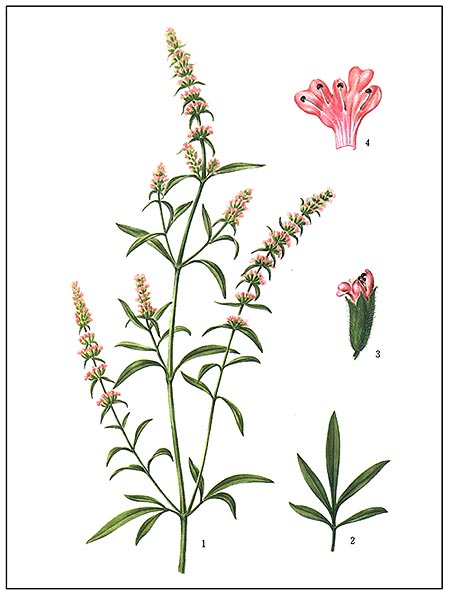
Figure 1: Mentha avarensis.

Figure 2: Schizonepeta tenuifolia.
MENTHA AND SCHIZONEPETA
Mentha and schizonepeta are Chinese herbs that are frequently combined in formulas for treatment of several "surface" disorders, including skin eruptions, sinus infections, headaches, common cold, and influenza. Because of their similarities, these two herbs are here described in a single article. Mentha and schizonepeta are of the Labiatae family of plants, commonly called the mint family, and both are categorized as surface-relieving agents in the modern Chinese Materia Medica guides. While there have been limited studies on the individual herbs, their use in traditional style formulas is extensive.
Mentha refers to Mentha averensis (see Figure 1) or Mentha haplocalyx. These are Chinese peppermints; Western peppermint is derived from Mentha piperita. The entire tops of the plant are used for the herb, known as bohe (bo refers to this specific mint, but the character is the same as the one meaning "thin" or "slight"; he refers to the water lily; hence, the thin water lily). The Materia Medica in which mentha was first described was the Tang Bencao, also known as the Xinxiu Bencao (659 A.D.), but there was brief mention of it in the earlier Leigong Paozhi Lun (ca. 470 A.D.). According to Oriental Materia Medica (1), mentha is pungent and cool, disperses wind-heat, cleanses the throat, and promotes skin eruptions; it is to be used for fever, headaches, hyperemia (excessive tearing), sore throat, oral and skin lesions, rash, and toothache. When treating a rash, this herb is described as helping to "bring the rash to the surface," implying that it can speed the disease process and help resolve it more quickly (reference is usually made specifically to measles; the herb is thought to benefit itchy rashes in general). In addition, mentha is said to promote the flow of liver qi, though this application tends to be limited; the reference prescriptions for this use are Bupleurum and Tang-kuei Formula, Xiao Yao San, and its modification Bupleurum and Peony Formula, Jiawei Xiao Yao San, which contain mentha for regulating liver qi.
The principal active constituents of mentha are the essential oils, which comprise about 1% of the herb. The oils are dominated by monoterpenes, mainly menthol, menthone, and their derivatives (e.g., isomenthone, neomenthol, acetylmenthol, pulegone). The essential oils dilate peripheral blood vessels and inhibit bacteria. These are the primary mechanisms of action of the herb in relation to treating surface disorders: dilating vessels induces perspiration and alleviates aching; antibacterial effects help resolve infections.
Menthol is often consumed in the West in candies and teas, with quantities of about 10 mg being ingested. Therapeutic amounts are much higher, about 100 mg of mixed essential oils. At 1% oil content, the amount of herb to be used to obtain 100 mg of the essential oils is at least 10 grams. There are some losses by evaporation during preparation of decoctions, so best results are attained by assuring adequate dosage of the herb and preparing the decoction carefully. To minimize the loss, mentha (and other herbs that depend on essential oils for their effects) are cooked for only a short time. Two or more herbs with similar essential oils may be combined to yield the total amount of terpenes needed to attain the desired physiological effects.
Schizonepeta refers to Schizonepeta tenuifolia (see Figure 2) or Schizonepeta multifida. These herbs are known as jingjie (jing = brambles; jie = the mustard plant; hence a brambly herb with mustard-like taste; the herb was also known formerly as jiasu, meaning false perilla, because it had a pungent taste similar to perilla, another member of the Mint family). The entire tops of the herb are used, and are collected when there is a large flower spike, in the autumn. The spike, known as jingjiesui, is the preferred portion. Schizonepeta was first described in the Advanced Textbook on Traditional Chinese Medicine and Pharmacology (ca. 100 A.D.) as acrid and warm, mainly used to treat cold and heat disorders, fistulas, and scrofulous swellings (2). According to Oriental Materia Medica, the herb dispels wind, resolves the surface, and controls bleeding; it is used for fever due to wind-cold, headache, laryngitis, carbuncle, tumor, and postpartum syncope. Like mentha, it is used to bring rashes to the surface in the treatment of measles and pruritis. Schizonepeta is carbonized (burned), or at least fried to a dark color, in order to produce a treatment for stopping bleeding; this may be its essential role in treating postpartum syncope: stopping hemorrhage that causes a loss of blood pressure and fainting. A well-known traditional formula for bleeding during and after pregnancy is Antai Yin, which includes fried schizonepeta.
The main active constituents of schizonepeta are understood to be the essential oils, which comprise about 1.8% of the tops and are dominated by the monoterpene aldehydes menthone and pulegone (see Figure 3). The physiological properties of menthone are essentially the same as those of menthol, namely dilating peripheral blood vessels, alleviating pain, and inhibiting bacteria. The monoterpenes in both mentha and schizonepeta may also have some ability to treat pruritis associated with allergy-caused rashes; pulegone has antiinflammatory and antipyretic effects (4).
When used individually, mentha is selected for formulas involving wind-heat syndromes, while schizonepeta is selected for formulas involving wind-cold. In treatment of skin eruptions, schizonepeta may be selected over mentha in the treatment of large swellings (e.g., carbuncles) even though the herb is described as warming. According to Advanced Textbook on Traditional Chinese Medicine and Pharmacology (5), schizonepeta is "warm but not dry, and its action is mild." Since mentha is well known as a mild herb that can be used as a beverage tea and flavor, of both these herbs can be depicted as being mild in nature and, therefore, can be administered with some degree of flexibility.
Following are examples of formulas in which mentha and schizonepeta are used for the treatment of surface disorders but are not combined. Note that the decoction form (tang) is rarely used; the other forms (mainly a powder, san, and liquid, yin) are prepared with shorter cooking times, which preserves the aromatic oils.
Mentha only
Schizonepeta only
Following are eight commonly used formulas (6) in which mentha and schizonepeta are combined. The ingredients are illustrated in table format; a listing of the formulas with their indications is presented after the table. The herbs are arrayed as follows: the main surface-relieving agents first (tang-kuei and cnidium included in this section for their wind-dispelling actions); the heat and toxin cleansing herbs next; followed by platycodon (used for swellings and phlegm) and licorice (included in all formulas, as an antiinflammatory and harmonizing agent); miscellaneous other ingredients are in the last row.
| Cnidium and Tea Formula | Lonicera and Forsythia Formula | Schizonepeta and Siler Formula | Schizonepeta and Forsythia Combination | Siler Combination | Siler and Platycodon Formula | Arctium Combination | Cimicifuga and Peucedanum Combination |
| mentha | mentha | mentha | mentha | mentha | mentha | mentha | mentha |
| schizonepeta | schizonepeta | schizonepeta | schizonepeta | schizonepeta | schizonepeta | schizonepeta | schizonepeta |
| cnidium | cnidium | cnidium | cnidium | cnidium | |||
| angelica | angelica | angelica | |||||
| chiang-huo | chiang-huo | ||||||
| tang-kuei | tang-kuei | ||||||
| bupleurum | bupleurum | ||||||
| arctium | arctium | arctium | |||||
| ginger, fresh | ginger, fresh | ||||||
| forsythia | forsythia | forsythia | forsythia | forsythia | forsythia | forsythia | |
| lonicera | lonicera | lonicera | |||||
| coptis | coptis | coptis | |||||
| scute | scute | scute | scute | ||||
| gardenia | gardenia | gardenia | gardenia | ||||
| platycodon | platycodon | platycodon | platycodon | platycodon | platycodon | ||
| licorice | licorice | licorice | licorice | licorice | licorice | licorice | licorice |
| tea, cyperus | phragmites, soja, lophatherum | peucedanum, tu-huo, chih-ko | peony, rehmannia, phellodendron, chih-ko | chih-shih | rhubarb, mirabilitum, ma-huang, atractylodes, talc, peony, gypsum | scrophularia, rhubarb, mirabilitum | cimicifuga, pueraria, chih-ko, apricot seed, akebia, peucedanum, lophatherum |
The formulas in the above table are indicated as having the following applications:
In all but one of the above formulas (the exceptions is Yin Qiao San), in addition to the two plants of the mint family, one or more herbs of the Umbelliferae (celery family) are included: siler, cnidium, angelica, chiang-huo, tang-kuei, and bupleurum. These Umbelliferous herbs also have the function of promoting peripheral circulation and alleviating pain. They are commonly used in treatments for arthritis (see: An analysis of Chinese herb prescriptions for rheumatoid arthritis). The table also reveals that the basic structure of the listed formulas revolves around the combination of six herbs that appear in almost every formulation: mentha, schizonepeta, siler, forsythia, platycodon, and licorice. These herbs are particularly effective for the symptoms of sore throat, headache, and skin eruptions.
In the Materia Medica category of surface-relieving herbs, the following other members of the Labiatae are included:
Like schizonepeta, all of these are said to be of warm nature, and the indications for use, although varying from one herb to another, reflect the pharmacological properties of the essential oils that are considered the main active components. One other mint fits with the herbs of this section: pogostemon (huoxiang). Although it is categorized with the fragrant herbs for resolving dampness (used mainly for summer-heat type syndrome), it is incorporated into modern formulas for treatment of surface ailments such as stuffy nose, headache, and common cold. It is aromatic, has a mild warm property, and is used for inducing diaphoresis, regulating qi, and resolving accumulated moisture in the center.


Figure 2: Schizonepeta tenuifolia.